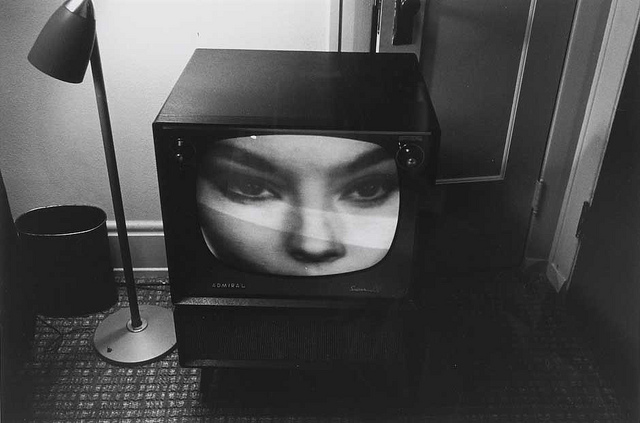
Wayne Bremser considers Google Maps Street View art, drawing an interesting comparison to 60s Americana photography capturing TV screens: One important process-related issue with GSV images that end up as photographs on a gallery wall is this: they are not screen grabs, but photographs of a screen. Whether the camera was employed to enable more megapixels for large printing, or as part of the conceptual artistic process, images created by the GSV device and compressed for the web are transformed somehow, perhaps with the air between monitor and camera. This is especially true with Rickard’s work. Spending time at the gallery, I noticed myself switching from paying attention to jpeg artifacts and evidence of the source, to finding the right distance and appreciating the colors and Rickard’s compositions. Photographs of screens with GSV scenes actually belong to a long tradition. How many families in America have taken photographs of the television? Of the moon landing, or the home team winning the World Series? The transformation is similar to what Rickard and the others are exploiting: a fuzzy TV signal on a crappy TV that makes its way into a Pittsburgh home, but becomes something different when captured by a decent Nikon lens. The resulting photograph doesn’t just capture the content of the TV screen, but the person’s desire to capture what was on the screen. Today GSV is just as fleeting as the World Series was in the pre-VCR or DVR era. There’s no way to know when Google will update a location and remove a scene. Robert Frank has a few television screens in The Americans, including one wonderful photo inside a television studio. Along with the insane pile of cables, at the same time the photograph shows both how a woman looks photographed by Robert Frank (torso obscured by a man’s arm) and how she appears on television (reduced in the tiny frame to just her talking head). Lee Friedlander took a series of photographs in the 1960’s that included screens (that were in a 1995 exhibit and subsequent book called “The Little Screens”). In the photos from this era the television is usually a small, glowing box in the corner of a room. Friedlander’s screens almost always have a person, but he moves in closer to capture faces. Friedlander is attracted to those moments where the facade peels back from the relatively new, perfectly sensible electronic communications medium and reveals a 1/125th of a second of raw, unpolished humanity. The GSV photographers, with the exception of Mason, seem to be looking for this same kind of moment. Where Mason and Rickard do their best to remove evidence of the web experience of GSV, Wolf and Jon Rafman are not afraid of the moiré patterns and the interface elements (arrows and labels) to create compositions that are not in the GSV photographs themselves. In this way they are more like Friedlander’s photos in “Little Screens,” which capture how the televisions are designed, how they sit in hotel rooms, and the distortions of transmission, the warped edges and burps of the early tubes.

